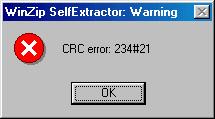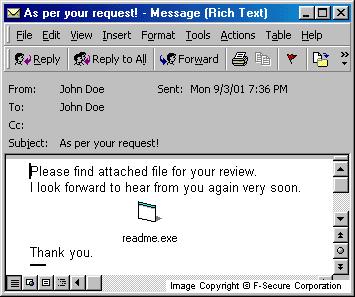Apost
Summary
Readme is a simple mass-mailer written in Visual Basic. The worm has been found in the wild on September 3rd, 2001. It is a PE EXE file 24576 bytes long. Its code is not compressed.
Removal
Based on the settings of your F-Secure security product, it will either move the file to the quarantine where it cannot spread or cause harm, or remove it.
A False Positive is when a file is incorrectly detected as harmful, usually because its code or behavior resembles known harmful programs. A False Positive will usually be fixed in a subsequent database update without any action needed on your part. If you wish, you may also:
-
Check for the latest database updates
First check if your F-Secure security program is using the latest updates, then try scanning the file again.
-
Submit a sample
After checking, if you still believe the file is incorrectly detected, you can submit a sample of it for re-analysis.
Note: If the file was moved to quarantine, you need to collect the file from quarantine before you can submit it.
-
Exclude a file from further scanning
If you are certain that the file is safe and want to continue using it, you can exclude it from further scanning by the F-Secure security product.
Note: You need administrative rights to change the settings.
Technical Details
When the worm's file is run it shows a messagebox with one big button labeled 'Open' and 'Urgent' as caption.

After a user clicks 'Open' button, the worm shows a fake error message:
WinZip SelfExtractor: Warning CRC error: 234#21

Then the worm checks if it is already installed in a system. It looks for README.EXE file in \Windows\ folder and creates it if it's not there. The worm then modifies the Registry - it adds 'macrosoft' subkey to the current user's application autostartup key:
[HKCU\Software\Microsoft\Windows\CurrentVersion\Run]
The 'macrosoft' subkey contains a full path for the worm's file. For example if Windows is installed with default settings, the subkey value will be 'c:\windows\readme.exe'. This way the worm starts every time when Windows is loaded.
The worm also copies itself as README.EXE to root directories of all drives that are available for writing (local and network drives where current user has write access).
Finally the worm connects to Microsoft Outlook, gets user's mail server login and password and sends itself to all email addresses found in Outlook's address book. The infected message looks like that:
Subject: As per your request! Body: Please find attached file for your review. I look forward to hear from you again very soon. Thank you. Attachment: Readme.exe

The worm's file is attached to an infected message as README.EXE file. It will infect a remote computer only when a recepient runs the attachment.
Infected messages are deleted after they are sent.
Instructions for manual removing: To remove this worm from a system it's enough to delete its file (README.EXE) from \Windows\ folder and from root directories of all drives that an infected computer has access to. If the worm's file is locked, it is advised to delete it from pure DOS or in case of Windows NT/2000 rename the file with a non-executable extension, reboot a system and then delete the previously renamed worm's file.
F-Secure Anti-Virus detects Apost worm with the updates available here:
https://www.europe.f-secure.com/download-purchase/updates.shtml